
RENAULT Espace
Generations Timeline, Specs and Pictures

Despite evolving into a niche model that is less mainstream than its predecessors, the Espace has always been an iconic car in the Renault lineup.
Its first four generations were family friendly MPVs, while its fifth one, unveiled in 2015, evolved into a high-end crossover with a one-of-a-kind design language. Four years later, Renault decided to the car give a mid-cycle facelift to keep it up to date with the rest of the modernized lineup.
Despite being a crossover-like car, with high ground clearance and a commanding driving position, the refreshed fifth-generation Espace still only powers its front wheels with an assortment of various four-cylinder engines in both gasoline and diesel flavor. The main differences compared to its predecessor revolve around the exterior design, which is now bolder, and the improved available technology features. The front end is all-new and features a redesigned bumper, a new lower front grille and transverse chrome elements to enhance the bold look of the car. The new rear bumper is fitted with a new skid plate to better accentuate the car’s crossover looks, while the C-shaped LED matrix adaptive headlamps at the front are not only cooler but also make the car safer at night. The interior has also been revamped, with the floating center console featuring a new closed storage area.
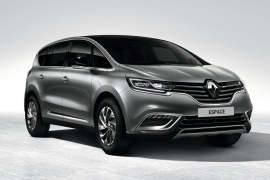
This is one of the best-known MPVs made in Europe: the Renault Espace.
Its origins are back in the ’80s and the French carmaker became very good in building it for the European roads. In 2014 it showed the fifth generation of its biggest car, which became more like a luxurious MPV crossover than a regular family carrier.
The design is far from what we’ve seen before in the Renault range. The Espace is built on a new platform developed together with its alliance partners from Nissan. Compared with its predecessors, the new vehicle is available in only one length of 4857 mm (15.9 ft). On the previous generation it used to be available in two wheelbase options. This one is available with 5 or 7 seat options.
Despite the big dimensions, the Espace is available only with four cylinder units. The 160 hp and 200 hp diesel engines have a 2.0-liter displacement, while the gasoline turbocharged unit is a 1.8 liter and offers 225 hp. The transmission for all variants is a 7-speed double-clutch unit.
The handling is eased by an all-wheel-steering system, which allows the rear wheels to steer or counter-steer to ease parking or to handle better at higher speeds.
The interior is part of the high-end luxury segment, with leather upholstery and an infotainment system caller R-LINK.

Renault introduced the fourth generation of the Espace range in 2002 and, by 2006, it had to improve it to the Euro 4 emission standards, but it did more than that.
The French carmaker offered the Espace in two lengths versions named Espace and Grand Espace. While the former was a practical MPV for families, the latter was often used as a VIP shuttle for hotels, companies, and airports. Renault made it to offer more comfort for the rear passengers. In 2006, along with the engine lineup upgrade, the carmaker added some improvements to the car’s exterior and interior.
From the outside, the 2006 Grand Espace featured similarly-shaped headlights as its non-facelifted version, covered with clear lenses. Its redesigned wrapped-around plastic bumper sported a pair of round fog lights on the lower side, flanking a broad black grille stretched from one side to another. The additional length was visible from its sides, especially on the last row of windows, which were longer. The car also sported a longer rear overhang.
Inside, Renault offered the Grand Espace in various configurations and up to eight seats in a 2-3-3 configuration. For the full-option level, named Initiale, the vehicle featured a leather-clad interior, a gigantic panoramic glass roof, and a multi-zone climate control system. The carmaker installed a long and wide dash panel with an instrument cluster installed in the middle. Thus, the rear passengers could read the speed on the digital speedometer.
Under the hood, Renault installed a wide choice of engines, most of them turbo-diesel. Unlike its predecessor, the Grand Espace was available exclusively with a front-wheel-drive.

After four years on the market, the fourth generation of the Espace received an update in 2006 to comply with the Euro 4 emission standards.
Renault introduced the Espace in 1984, and it became the MPV market leader. It was one of the most practical family vehicles thanks to its enormous interior space but kept the length within the mid-size sedan segment. With the facelifted version, Renault improved the car’s look, the interior, and the drivetrains. And it did all that in a package that received a five-star rating with flying colors at the Euro NCAP crash-tests.
From the outside, the 2006 Espace featured similarly-shaped headlights as its non-facelifted version, covered with clear lenses. Its redesigned wrapped-around plastic bumper sported a pair of round fog lights on the lower side, flanking a broad black grille stretched from one side to another. The carmaker introduced a new taillights design at the back, which dropped the formerly used round lams and adopted the squared ones, more suitable for the car’s overall wedged shape.
The Espace was available with up to seven seats in various configurations. While the third row was not as comfortable as the other two, it still provided plenty of legroom for two children. For the full-option level, named Initiale, the vehicle featured a leather-clad interior, a gigantic panoramic glass roof, and a multi-zone climate control system. The carmaker installed a long and wide dash panel with an instrument cluster installed in the middle. Thus, the rear passengers could read the speed on the digital speedometer.
Renault offered an engine for any needs. It started with a fuel-efficient but sluggish, 1.9-liter turbo-diesel and went up to a potent, 245 hp 3.0-liter V-6 gasoline unit. The carmaker introduced a six-speed automatic gearbox for the 3.0-liter V-6 turbo-diesel starting with the 2006 model year.

Continued in 2002 with a new model, the Renault Espace series gathered a lot of fans all around the world, although the sales in the first years of availability were pretty low.
If at the beginning, the MPV wasn’t quite an attractive body style, the Espace grew in popularity and became one of the main Renault models. The 2002 model is the first Espace built entirely by Renault after the previous ones were made by the French company Matra. One of the first things you’ll notice when comparing the 2002 and 1997 models is the redesigned grille which now encircles the logo while the headlights have been extended a little bit to the A pillar.
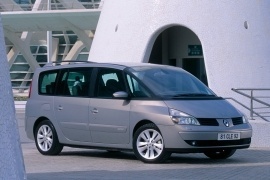
Renault introduced the fourth generation of the Espace in 2002 and offered it in two lengths, with seating for six and a larger trunk for the long-wheelbase version.
The Espace was the first successful minivan built by a European carmaker, and it was based on a project made for Matra in the late ’70s and rejected by Peugeot for being too bold. Renault bought it and hit the jackpot with it. It took its competitors almost a decade to catch up. In 2002, the Espace reached its fourth generation, and it was already playing in the VIP Shuttle segment, especially in the long-wheelbase version named Grand Espace.
By 2002, the new-edge design was already embraced by most European carmakers, and the Espace showed that on its front fascia. The angular-shaped headlights flanked a clear-cut grille which sported the “bird-beak” slat in the middle, like its stablemates Laguna and Clio. On the sides, the Grand Espace featured a longer rear overhang and a wider third set of windows behind the rear doors. The only downturn for the vehicle was the lack of sliding doors, which Renault considered too expensive.
Inside, the Grand Espace cabin received three rows of seats. It was available either in a 2-3-2 configuration or a 2-2-2 system. The latter left some passage area for the rear-seat passengers. The Espace sported a mid-mounted instrument panel with a green and black LCD on its long and wide dashboard. Thanks to the high-mounted seats, there was plenty of legroom for all the occupants on board, even for those seated in the last row.
Under the hood, Renault installed a choice of two gasoline and three turbo-diesel engines, paired with either a six-speed manual or a five-speed automatic for most of the range. The 3.0-liter V-6 received a standard six-speed automatic.

The 1997 model of Renault Espace represents the real second generation Espace introduced after the 1991 facelift although some people call it the third generation.
The new Espace comes with a completely new interior with the speedometer mounted in the center of the dashboard. What’s interesting is that this model is the latest Espace manufactured by Matra, the whole production line being then moved to Renault which started building Espaces since the introduction of the third generation. The 1997 edition also came with new engines, the most important addition being represented by a 3.0-liter V6 24V which produced 194 horsepower.
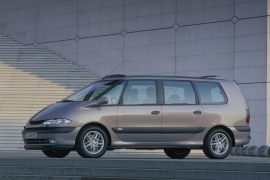
Presented in 1998, Renault Grand Espace is regarded as the perfect MPV that combines a spacious interior with enough room for all the passengers with a very large space for luggage.
The Grand Espace is a bigger version of the base model of Espace and comes with a choice of five engines, ranging between 2.0- and 3.0-liter. The top engine in this series is the 3.0-liter V6 24V with produces 194 horsepower and a maximum speed of 205 km/h. Standard features include ABS, remote central locking, air conditioning and CD player. The Grand Espace also provides advanced safety, a fact also underlined by the four-star rating gained at the EuroNCAP tests.
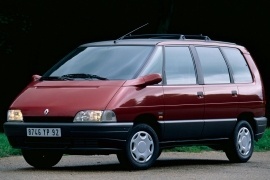
The 1991 Renault Espace is the facelifted version of the 1985 model which now comes with multiple exterior and interior improvements although the chassis is entirely unchanged.
The rectangular headlights of the previous Espace edition have been reshaped while the grille was reduced in order to follow the same design line of the French manufacturer. The engine options have also been changed, being now available in three configurations as it follows: a 2.1 dT 88 hp, 2.2i 110 hp and V6i 152 hp. This new model was kept in production until 1997 when Renault upgraded the whole range with a new generation.
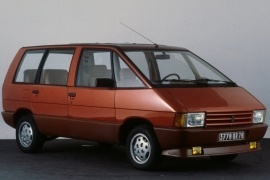
The 1984 Renault Espace was the car that started the MPV revolution in Europe.
It was conceived as a vehicle fit for families, for a taxi, for shuttle services, and leisure.
A series of events made the Espace to be launched as a Renault, even if it wasn’t designed to be made under that name. It was designed by a British designer for Chrysler and developed by the French coachbuilder Matra for Simca. Simca was a member of Chrysler Group along with Talbot. The financial problems led Chrysler to sell Simca to Peugeot, who didn’t want to produce the car. Matra, after it invested in the project, sold the concept to Renault who, in the end, launched the car in July 1984 and it was a huge success.
The design was unique on the market. Its single-box design with a sloped front and big windows all-around were unusual. The car was higher than the regular cars and that gave the occupants a better view and an increased safety feeling.
The biggest advantage of the vehicle was the interior, which featured up to seven seats. Apart from the driver’s seat, all the others could have been removed. The front seats could have been swiveled with 180 degrees so it could form a meeting room. Or, if the car was fitted with the option for a table, a dining room. Not to mention that the second and last row of seats could have been reclined and form a king-size bed.
The platform was built for longitudinal engines. Renault installed a 2.0-liter and 2.2-liter gasoline units in the beginning. A 2.1-liter turbo diesel was added later. It was mated to a standard 5-speed manual.























































